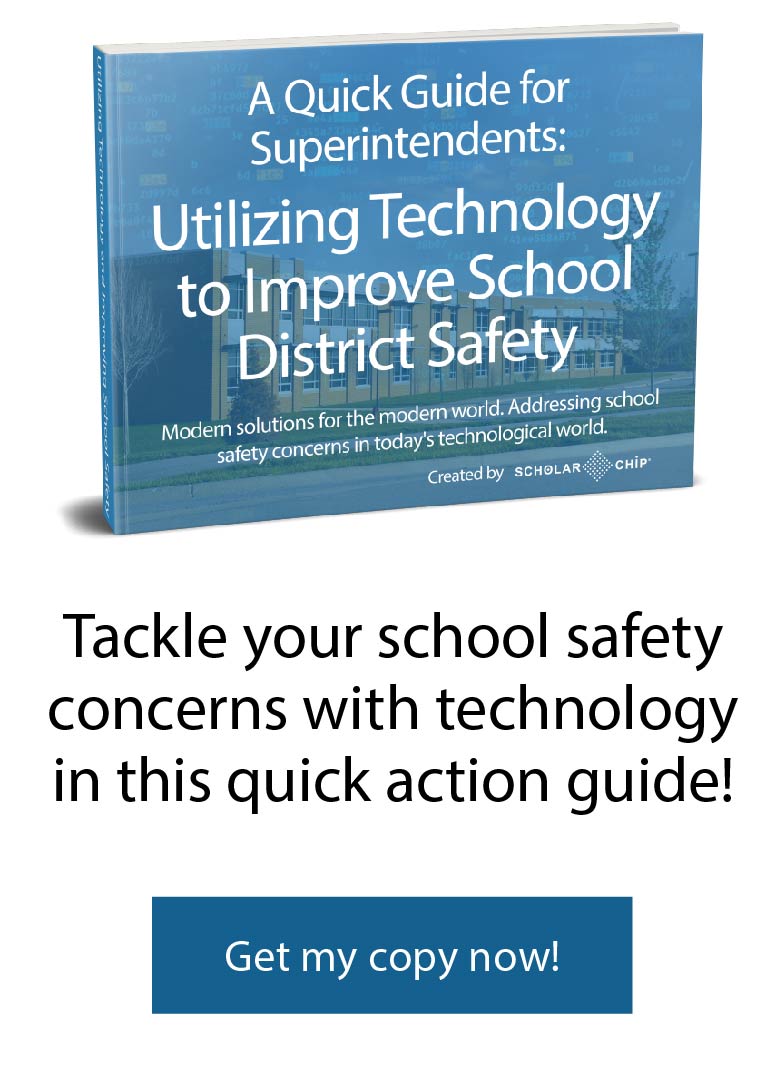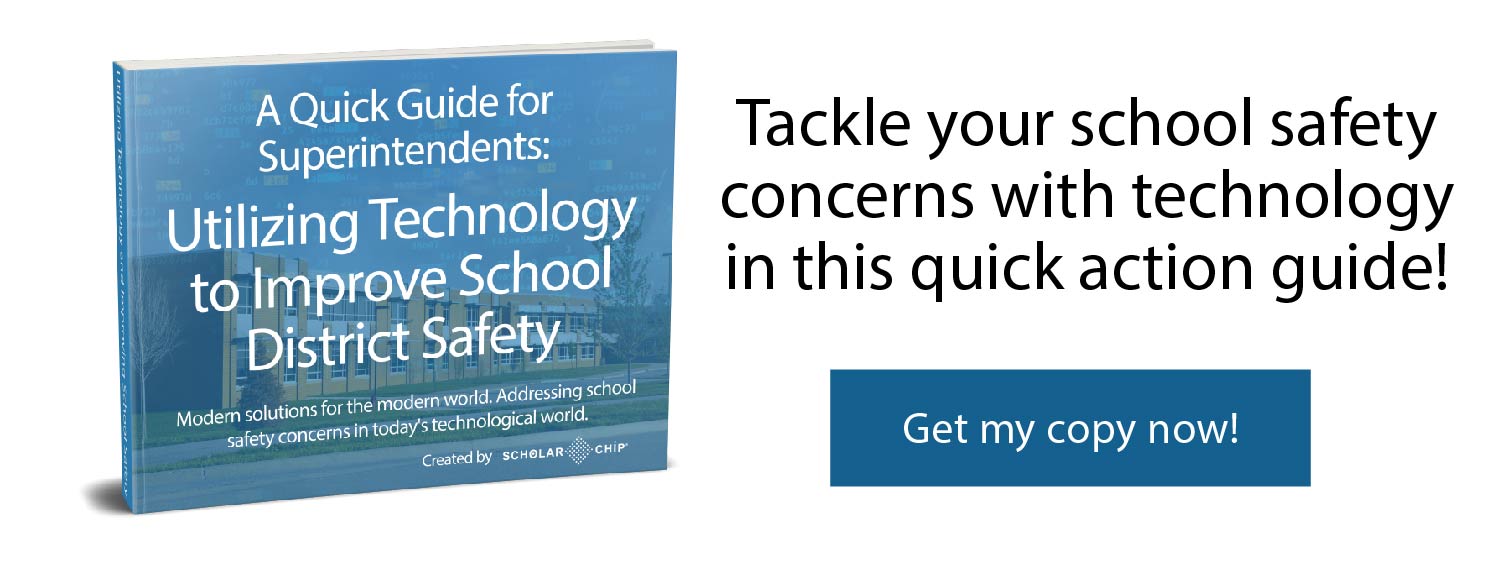The rapid evolution of educational technology has created new and exciting ways to teach, to learn and to measure student achievement. New systems streamline school operations, expedite communications and provide rich data to inform decisions. Unfortunately, software and infrastructure, considered cutting edge when installed, too soon becomes obsolete. As school leaders revisit their school technology plan, they must assess current technology needs and estimate future needs. Increasingly, these needs include security systems.
Technology use in support of school safety has become a critical component of any school technology plan. Low-tech solutions are no longer adequate to address safety concerns. The public needs assurance that schools are thinking beyond schoolyard tussles and protecting students and staff against the possibility of violent intruders. Systems that rely on sign-in sheets, stick-on name badges, and manually recorded attendance have easily exploited vulnerabilities. Updated, integrated information systems can address these weaknesses while increasing operational efficiency for a positive return on investment.
Prevalent Threats to Students and School Personnel
As most school leaders recognize, the media attention given to school shootings is disproportionate to the actual risk. However, security plans must consider the possibility of a violent intruder and include measures to thwart attacks. Dangers far more common, according to the most recent NCES Indicators of School Crime and Safety, are incidents of bullying, fighting, and other nonfatal victimizations. Underlying these threats to school security is a school climate that breeds hostility and fear.
In response to the February 2018 shooting at Marjory Stoneman Douglas High School, U.S. Department of Education joined with other federal agencies to form the Commission on School Safety. The Commission, tasked with aggregating and reviewing studies on school violence, issued its final report December 2018. The Commission found that while perpetrators of school violence came from diverse backgrounds and span age and racial groups, the one commonality appears to be that those who act out with violence suffer feelings of isolation and often were victims of bullying. For this reason, the Commission recommends schools curate a positive “culture of connectedness.” Students must feel they are part of the school community and are connected to their teachers and peers.
RAND research, in a 2016 study, found that most violent incidents occur in isolated areas of the school building. This is not surprising, but monitoring hundreds of students is a challenge. Younger students and those with special needs can be lost or left behind in classrooms, buses or on the playground. Truant students pose a risk to themselves and possibly others. Building administrators are held responsible for the safety of all students, yet protecting students becomes an impossible task when they can’t be located. Technology offers solutions to improve school climate, involve students in their behavior management and keep track of everyone in the building.
The Weaknesses of Legacy Systems
The closing decade of the 20th Century saw a revolution in technology that had schools investing in systems and infrastructure to facilitate operations. Schools across the country took advantage of federal programs to purchase computers and wire buildings for internet connections – most schools invested in software and digitized student records. Educators traded in pen and paper grade books and attendance logs for digital versions.
These disparate information systems are now obsolete. They require manual data entry, which is prone to human error, and data isn’t recorded in real-time. Students may enter a building, but their presence isn’t noted until a classroom teacher calls roll and types it into the system. Student information and administrative systems operate independently of each other, making it difficult to produce complete data sets necessary for effective decision-making. An individual student’s attendance data is separate from behavior and academic records giving educators an incomplete picture. When information is scattered over the course of a student’s K – 12 education, it is difficult to identify problems, possible threats, and determine effective interventions.
Security Measures to Incorporate into Your School Technology Plan
Door Access
The first, most obvious, security measure schools take against threats is to secure doors. Smart card technology makes it possible to replace keys with card readers so that only authorized personnel are allowed entry into the building or specific rooms in the building. Individual permissions may be set to particular days and times, preventing unauthorized people from entering restricted areas. By installing a secure door access system, school administrators may remotely extend or revoke access permissions and lock or unlock every door in the building.
Visitor Management
Throughout the day, vendors, parents and other members of the community visit school buildings. A visitor management system that incorporates driver’s license scanning can record the visitor’s identity, print an ID badge, flag those who have been identified as a threat, document their time-in, time-out and reason for the visit. By integrating visitor management with student information systems, staff may verify who is authorized to pick up a student, avoiding issues that often arise with custody disputes.
Automated Attendance
Smart ID cards for students utilize specific technology that allows students to check themselves into school, classrooms and group gathering areas such as the library or cafeteria by tapping or swiping their ID card. Attendance is automatically recorded, and the information is immediately available to administrators; they will know exactly who is in the building at all times. Mobile applications make it possible to record attendance on buses, during field trips, and extracurricular activities. Teachers do not have to spend the first few minutes of class calling roll and attendance information is more accurate than manually entered data.
Comprehensive Behavior Management
Traditional behavior management systems rely on a teacher’s handwritten notes and office referrals. Reporting of behavior incidents is inconsistent and, over the years and across grade levels, a student’s records may be spread out in multiple filing cabinets. Patterns of problematic behavior may go unidentified. A behavior management system integrated with a school’s SIS program brings all the pieces together in one place. A user-friendly interface makes it easy for staff to record incidents, interventions and results.
These systems strengthen school security without being obtrusive. While metal detectors, surveillance cameras, and uniformed security guards seem to be security solutions, they may do more harm than good. According to the National Association of School Psychologists, these overt measures tend to increase fear within the school creating a climate that prioritizes individual survival over connectedness. Smart ID cards, visitor management systems and doors secured with card readers are less foreboding.
Automated attendance systems promote a favorable school climate as they give students a sense of ownership in their school by providing an increased level of autonomy and accountability. Integrated systems also facilitate internal and external communications. Email, text and voice systems may be controlled from a central portal and programmed to respond to specific needs, such as sending an email to a parent when their child has arrived at school.
With new, integrated systems, school administrators have access to accurate, complete real-time data to identify threats better and inform decisions. Data is stored in the cloud unaffected by physical damage to a school’s onsite servers and is accessible from remote locations.
Districts have many options when it comes to updating technology, but only ScholarChip offers a fully integrated suite of tools for ID management, automated attendance, comprehensive behavior management, and secure door access. These systems may be implemented in stages as you retire legacy IT, and they are designed to expand as needs and budgets change.
ScholarChip is an all-in-one, platform solution to help reduce school threats and addresses the important issues surrounding school safety. Data from students, faculty, and stakeholders are leveraged to manage school access, attendance, and behavior management through the platform tools to increase safety and promote the campus climate schools are looking for.
If you would like to learn more about how you can you can utilize technology to reduce school threats from occurring, feel free to schedule a free 1-on-1 strategy session with one of our solution specialists!


